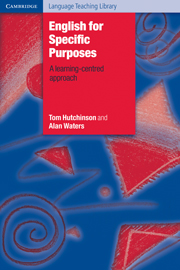13 - Orientation
Published online by Cambridge University Press: 03 May 2010
Summary
I have been a stranger in a strange land.
(Exodus 2:22)ESP teachers are all too often reluctant dwellers in a strange and uncharted land. In this chapter we shall consider this situation in greater detail, focussing on three problems which we have found consistently arise in discussions with teachers of ESP:
the lack of an ESP orthodoxy to provide a ready-made guide;
the new realms of knowledge the ESP teacher has to cope with;
the change in the status of English Language Teaching.
We shall consider each of these and offer some suggestions as to how a learning-centred approach can help.
The lack of an orthodoxy
In spite of its relatively brief existence, ESP has undergone a number of major shifts in orientation. These have come about largely because ESP has developed at a time when a fundamental revision of our view of language and learning has been taking place. Lacking a long tradition which might give some stability, ESP has frequently been a hotbed of conflict – the Wild West of ELT. New settlers in this land must often have found it difficult to find their bearings with no agreed maps to guide them. The question of authentic texts will illustrate the kind of problem that arises.
In the early stages of ESP there was no question of using authentic texts. Writers such as A. J. Herbert (1965) created their own texts to highlight language features much in the same way as was done in General English. This tradition was continued in the era of discourse analysis.
- Type
- Chapter
- Information
- English for Specific Purposes , pp. 158 - 169Publisher: Cambridge University PressPrint publication year: 1987



